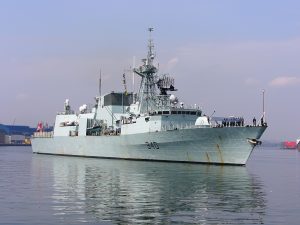Canada is looking to build some impressive new frigates, but it first needs to deal with an increasingly common problem: the tyranny of export controls. One of Canada’s partners in the frigate project is objecting to the use of electronics in the construction project, and has asked for direct negotiations with the Canadian government.
Based on the Royal Navy’s Type 26 frigates, Canada’s newest frigates will displace around 7,000 tons and carry a 32-cell vertical launch system (VLS). The VLS will reportedly be capable of launching Tomahawk land and maritime attack missiles, along with a variety of defensive weapons. The ships will undoubtedly operate in the Atlantic and the Pacific as well as Canada’s increasingly accessible Arctic coastline.
The ships are intended to replace Canada’s Halifax-class frigates, and represent Ottawa’s biggest naval procurement project in a generation. But the program faces a speedbump; one of the states that hosts one of the companies involved in the production of the ship has hit the brakes, claiming that there are problems over the use of proprietary electronics on the ships. The ally, which has not been identified, insisted on government-to-government negotiations with Ottawa, rather than handling the issue through subnational industrial negotiations.
This kind of story has become common, although it less commonly involves allies and domestic production contracts. Tight export controls, combined with increasingly transnational nature of the defense industry, has created nodes of “weaponized interdependence” that enable well-connected states to deny advanced military technology to their competitors, or to other states that they find unreliable. In some cases, this enables states to completely undercut efforts by competitors to buy advanced military technology. Recently, for example, the United Kingdom shut down the transfer of FA-50 jet fighters from Korea Aerospace Industries (KAI) to Argentina based on British ownership of some of the technologies incorporated in the aircraft. A similar effort prevented Argentina from acquiring the Swedish Gripen fighter. This phenomenon represents yet another way in which intellectual property protection impacts how governments make national security decisions.
In this case, one of Canada’s partners seems to be leveraging its ownership of technology to get a better deal during the construction process. It seems likely that Canada and the unnamed partner will be able to sort the problem out, as Canada does not represent any kind of real security risk to any of its potential partners. Nevertheless, as the global defense industry becomes more complex and transnational, governments and companies will increasingly see opportunities for creating negotiating leverage, either through creative use of export controls or through maintaining direct ownership of critical technologies. In the long run, this may spur countries to keep defense procurement as much as possible in the hands of domestic companies, rather than international partners.

































